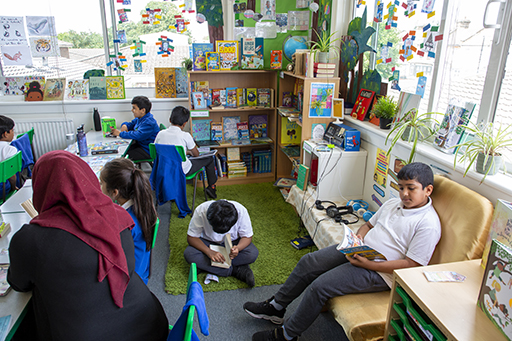8 Social reading environments
Reading environments in schools invite readers to engage and share the pleasures of reading. They contextualise reading aloud, supported independent reading and book talk activities, which indicates that the strands of RfP pedagogy operate in complex combination.
Each strand of RfP pedagogy highlights the role that social interaction plays in children’s development as childhood readers. Through interaction, networks of readers – both small affinity groups and larger communities of readers – are built, which can help alter children’s perception of reading. Two studies of children’s lived experience of RfP in classrooms show that initially they viewed reading as a required school-based solo activity, but over the year came to see it as a more social and communal activity (Cremin et al., 2014; Moses and Kelly, 2018). The teachers’ perceptions of reading also altered; they began to appreciate the social and relational nature of reading (Cremin et al., 2014) and worked to build communities within and beyond school, something you will look at in more detail in Session 6.

Reading environments encompass the physical resources (i.e. displays, books) as well as the social element (i.e. staff, children, visitors). It is easy to assume that if the former is well resourced, and time and effort has gone into creating attractive reading areas for instance, the latter will operate effectively. However, research indicates this is not the case and that acts of RfP ‘window dressing’ abound. For instance, in a study of disengaged boy readers (aged 9-10), the dedicated classroom reading areas were predominantly used for time-out for bad behaviour and as extra workspaces, and rarely for volitional reading (Hempel-Jorgensen et al., 2018). Furthermore, the reading displays were not made or owned by the children, but by staff who, pressured to raise standards, profiled reading as proficiency both physically and in interaction. No displays showed texts to tempt readers, and both reading time and reading aloud were teacher-led, relatively formal, and with very few opportunities for interaction beyond replying to teachers’ questions. In addition, almost no informal book talk was documented (Hempel-Jorgensen et al., 2018).
Personal reflection 3
Imagine your classroom (or one you know) with children arriving in the morning or after lunch.
- What explicit or implicit messages about reading are evident?
- What does the atmosphere tell you about the social nature of the reading environment?
- Can you see/hear mini networks of engaged readers?
Comment
Every classroom carries messages about reading, so you will want to consider if your reading area and related displays promote and entice readers. Perhaps the key message is one of proficiency, with lists of key comprehension strategies and no outward facing texts, in which case RfP is not being foregrounded. In addition, who made the area and how child owned and shaped is it?
In reading environments that are inherently social, children will seize opportunities to talk to each other about what they are reading and to share texts of all kinds, so to some extent you can see and feel the social nature of reading. You will notice this behaviour around the school too, on the playground, when lining up and over lunch. In richly social reading environments this will involve the adults as well.

Optional resource
For more practical classroom strategies to refine and shape your reading environment and all four strands of RfP pedagogy [Tip: hold Ctrl and click a link to open it in a new tab. (Hide tip)] visit The Open University’s Reading for Pleasure website.
Knowing how to track the impact of your four stranded RfP pedagogy is essential, as you will consider next.
